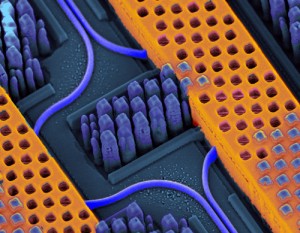 IBM has demonstrated that it is commercially feasible to bake optical circuitry into silicon processors using existing fabrication techniques, which could set the stage for radically faster and lower-cost computer communications.
IBM has demonstrated that it is commercially feasible to bake optical circuitry into silicon processors using existing fabrication techniques, which could set the stage for radically faster and lower-cost computer communications.
Silicon nanophotonics, as IBM calls its technology, could radically simplify and extend the design of optical networking equipment. In much the same way integrated circuits provided a way to easily bundle billions of individual transistors into powerful microprocessors, silicon nanophotonics could shrink optical componentry into far smaller, and way more powerful, form factors.
The researchers will discuss their work at the IEEE International Electron Devices Meeting this week in San Francisco. They will describe how IBM was able to build optical modulators and photodetectors on a single silicon chip, using standard 90-nanometer semiconductor fabrication techniques — an industry first, they claim.
Such components could be used to create a WDM (wavelength division multiplexing) transceiver on a chip that could communicate data at rates up to 25Gbps. With this fabrication process, it would be theoretically possible to develop a single chip that could communicate data at a terabit per second or more.
IBM researchers have been working on this technology for over 10 years, said Solomon Assefa, a nanophotonics scientist for IBM Research, who was involved in the work.
The company published a proof of concept for these technologies in 2010, but this new work focuses on how to build optical components using existing fabrication processes, without compromising the reliability or performance of individual transistors. Additional work was done on formulating a way to fabricate components at reasonable costs.
In general, transmitting data with light signals can be superior to using electrons over wire, Assefa said. Light signals move more quickly than electronic signals. Multiple light signals of different wavelengths can be run over one another in the same conduit. Also, in optimum conditions, light can travel for longer distances without the need for regeneration.
Today, optical networking components used to run fiber optic networks are assembled from different individual silicon and photonic components. Putting all the functionality onto a single chip would save money because it would “leverage the tools and the processes that already exist in the micro-electronics industry,” Assefa said.
Silicon also allows for “very dense integration,” Assefa said. “Instead of just having one lane, you can have 50 of them. Out of a single chip, you could get a huge amount of bandwidth.”
As a result, silicon nanophotonics could simplify and lower the cost of the routing componentry needed to run fiber optic networks. It could also be used to facilitate faster data communication inside computers themselves, replacing the electronics-based buses now in use.
One eager user of this technology might be the field of high-performance computing. The bottlenecks in today’s supercomputers are not the processors themselves, but the rate at which data can be moved across processors and memory. “They are suffering because the interconnects that exist are limited in bandwidth, not scalable and expensive,” Assefa said.





